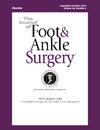常规 X 射线照相术在跖骨骨折非手术治疗中的价值:一项回顾性队列研究。
IF 1.3
4区 医学
Q2 Medicine
引用次数: 0
摘要
尽管常规X光片被广泛应用于后续治疗方案中,但其对跖骨骨折患者非手术治疗临床决策的附加价值尚不明确。这项回顾性队列研究旨在确定常规随访X光片是否有助于改变跖骨骨折患者非手术治疗的治疗策略。研究纳入了 2020 年 5 月 1 日至 2022 年 5 月 2 日期间因跖骨骨折接受非手术随访治疗的成人(年龄≥18 岁)患者。所有相关数据均从患者病历中提取。无临床指征记录的X光片被列为常规检查。研究结果包括在后续治疗中根据常规射线照片改变治疗策略,其次是根据有临床指征的射线照片改变治疗策略。共纳入了 168 例患者,其中 135 例为单跖骨骨折,33 例为多跖骨骨折。在随访期间,共进行了 223 次射线照相,其中 154 次(69%)为常规射线照相,69 次(31%)为临床指征射线照相。在常规X光检查中,有9例(6%)导致治疗方法的改变,其中仅包括额外的影像学检查。没有观察到根据常规射线照相而改用手术治疗或延长固定时间的情况。在有临床指征的放射线检查中,16 例(23%)导致治疗方法的改变,包括延长固定时间(2 例)、增加复诊时间(1 例)和增加影像学检查(12 例)。我们的研究结果表明,在跖骨骨折的非手术治疗中,常规的放射线检查很少会影响治疗策略,这表明放射线检查对临床决策的附加值极低。在治疗方案中省略常规X光检查可能有助于减少临床实践中不必要的医疗资源使用。临床证据级别:3.本文章由计算机程序翻译,如有差异,请以英文原文为准。
The Value of Routine Radiography in the Nonoperative Treatment of Metatarsal Fractures: A Retrospective Cohort Study
Although widely used in follow-up treatment protocols, the added value of routine radiographs to clinical decision-making in nonoperative treatment of patients with metatarsal fractures is unclear. This retrospective cohort study aimed to determine whether routine follow-up radiographs contributed to changes in treatment strategies in nonoperative treatment of patients with a metatarsal fracture. Adult (aged ≥ 18 years) patients who received nonoperative follow-up treatment for a metatarsal fracture between May first, 2020 and May second, 2022 were included. All relevant data were extracted from patient records. Radiographs without a documented clinical indication were classified as routine. Outcomes included changes in treatment strategies based on routine radiographs during follow-up treatment and secondarily, changes in treatment strategy based on clinically indicated radiographs. A total of 168 patients were included, with 135 single and 33 multiple metatarsal fractures. During follow-up, 223 radiographs were performed, of which 154 (69%) were routine and 69 (31%) were on clinical indication. Of routine radiographs, 9 (6%) led to a change in treatment which only included additional imaging. No switch to operative treatment or prolonging of immobilization was observed based on routine radiographs. Of clinically indicated radiographs, 16 (23%) led to a change of treatment, including prolonged immobilization (n = 2), additional follow-up appointments (n = 1) and additional imaging (n = 12). Our results show routinely performed radiographs seldom affect treatment strategies in nonoperative treatment of metatarsal fractures, indicating minimal added value to clinical decision-making. Omitting routine radiographs from treatment protocols may contribute to the reduction of unnecessary healthcare resource utilization in clinical practice.
求助全文
通过发布文献求助,成功后即可免费获取论文全文。
去求助
来源期刊

Journal of Foot & Ankle Surgery
ORTHOPEDICS-SURGERY
CiteScore
2.30
自引率
7.70%
发文量
234
审稿时长
29.8 weeks
期刊介绍:
The Journal of Foot & Ankle Surgery is the leading source for original, clinically-focused articles on the surgical and medical management of the foot and ankle. Each bi-monthly, peer-reviewed issue addresses relevant topics to the profession, such as: adult reconstruction of the forefoot; adult reconstruction of the hindfoot and ankle; diabetes; medicine/rheumatology; pediatrics; research; sports medicine; trauma; and tumors.
 求助内容:
求助内容: 应助结果提醒方式:
应助结果提醒方式:


